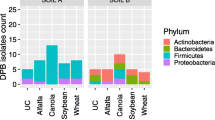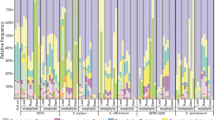Abstract
Background
The use of plant growth-promoting microorganisms represents a sustainable way to increase agricultural yields and plant health. Thus, the identification and tracking of these microorganisms are determinants for validating their positive effects on crops. Pangenomes allow the identification of singletons that can be used to design specific primers for the detection of the studied strains.
Objective
This study aimed to establish a strategy based on the use of whole-genome sequencing and pangenomes for designing and validating primer sets for detecting Bacillus cabrialesii TE3T, Priestia megaterium TRQ8, and Bacillus paralicheniformis TRQ65, a promising beneficial bacterial consortium for wheat.
Methods and Results
The identification of singletons of TE3T, TRQ8, and TRQ65 was performed by pangenomes using the Kbase platform and subsequently analyzed using BLAST®. The identified DNA regions were used for primer design in AlleleID version 7. Primers were validated by multiplex PCR using pure template DNA from each studied strain, combinations of two or three DNA from these strains, and DNA from agricultural soil samples enriched (and not) with the bacterial consortium. Here, we report the first design of primers capable of detecting and identifying the beneficial strains TE3T, TRQ8, and TRQ65.
Conclusions
The use of pangenomes allowed the distinction of unique sequences that enables the design of primers for specific identification of the studied bacterial strains. This strategy can be widely used for the design of primer sets to detect other strains of interest for combating biopiracy, and commercial protection of biological products, among other applications.




Similar content being viewed by others
References
Lopez E, Hertel T (2021) Global food waste across the income spectrum: Implications for food prices, production and resource use. Food Policy 98:101874. https://doi.org/10.1016/j.foodpol.2020.101874
de los Santos VS, Parra Cota FI, Herrera Sepúlveda A, Valenzuela Aragón B, Estrada Mora JC (2018) Colmena: colección de microorganismos edáficos y endófitos nativos para contribuir a la seguridad alimentaria nacional. Revista Mexicana de Ciencias Agrícolas. 9:191–202. https://doi.org/10.29312/remexca.v9i1.858
de los Santos-Villalobos S, Díaz-Rodríguez AM, Ávila-Mascareño MF, Martínez-Vidales AD, Parra-Cota FI (2021) COLMENA: a culture collection of native microorganisms for harnessing the agro-biotechnological potential in soils and contributing to food security. Diversity (Basel) 13:337. https://doi.org/10.3390/d13080337
de los Santos-Villalobos S, Robles RI, Parra FI, Larsen J, Lozano P, Tiedje J (2019) Bacillus cabrialesii sp. nov., an endophytic plant growth promoting bacterium isolated from wheat (Triticum turgidum subsp. durum) in the Yaqui Valley, Mexico. Int J System Evolut Microbiol 69:3939–3945. https://doi.org/10.1099/ijsem.0.003711
Robles-Montoya RI, Parra-Cota FI, de los Santos-Villalobos S (2019) Draft genome sequence of Bacillus megaterium TRQ8, a plant growth-promoting bacterium isolated from wheat (Triticum turgidum subsp. durum) rhizosphere in the Yaqui Valley, Mexico. 3 Biotech. https://doi.org/10.1007/s13205-019-1726-4
Valenzuela-Ruiz V, Robles-Montoya RI, Parra-Cota FI, Santoyo G, del Carmen Orozco-Mosqueda M, Rodríguez-Ramírez R, de los Santos-Villalobos S (2019) Draft genome sequence of Bacillus paralicheniformis TRQ65, a biological control agent and plant growth-promoting bacterium isolated from wheat (Triticum turgidum subsp. durum) rhizosphere in the Yaqui Valley, Mexico. 3 Biotech. https://doi.org/10.1007/s13205-019-1972-5
Robles-Montoya RI, Chaparro-Encinas LA, Parra-Cota FI, de los Santos VS (2020) Mejorando rasgos biométricos de plántulas de trigo con la inoculación de un consorcio nativo de Bacillus. Revista Mexicana de Ciencias Agrícolas 11:229–235. https://doi.org/10.29312/remexca.v11i1.2162
Rojas-Padilla J, Chaparro-Encinas LA, Robles-Montoya RI, de los Santos VS (2020) Promoción de crecimiento en trigo (Triticum turgidum L. subsp. durum) por la co-inoculación de cepas nativas de Bacillus aisladas del Valle del Yaqui México. Nova Scientia. https://doi.org/10.21640/ns.v12i24.2136
Villa-Rodríguez E, Parra-Cota F, Castro-Longoria E, López-Cervantes J, de los Santos-Villalobos S (2019) Bacillus subtilis TE3: a promising biological control agent against Bipolaris sorokiniana, the causal agent of spot blotch in wheat (Triticum turgidum L. subsp. durum). Biol Control 132:135–143. https://doi.org/10.1016/j.biocontrol.2019.02.012
Villa-Rodriguez E, Moreno-Ulloa A, Castro-Longoria E, Parra-Cota FI, de los Santos-Villalobos S (2021) Integrated omics approaches for deciphering antifungal metabolites produced by a novel Bacillus species, B. cabrialesii TE3T, against the spot blotch disease of wheat (Triticum turgidum L. subsp. durum). Microbiol Res 251:126826. https://doi.org/10.1016/j.micres.2021.126826
Ibarra-Villarreal AL, Gándara-Ledezma A, Godoy-Flores AD, Herrera-Sepúlveda A, Díaz-Rodríguez AM, Parra-Cota FI, de los Santos-Villalobos S (2021) Salt-tolerant Bacillus species as a promising strategy to mitigate the salinity stress in wheat (Triticum turgidum subsp durum). J Arid Environ 186:104399. https://doi.org/10.1016/j.jaridenv.2020.104399
Baudoin E, Couillerot O, Spaepen S, Moënne-Loccoz Y, Nazaret S (2010) Applicability of the 16S–23S rDNA internal spacer for PCR detection of the phytostimulatory PGPR inoculant Azospirillum lipoferum CRT1 in field soil. J Appl Microbiol 108:25–38. https://doi.org/10.1111/j.1365-2672.2009.04393.x
Atkins SD, Clark IM, Pande S, Hirsch PR, Kerry BR (2005) The use of real-time PCR and species-specific primers for the identification and monitoring of Paecilomyces lilacinus. FEMS Microbiol Ecol 51:257–264. https://doi.org/10.1016/j.femsec.2004.09.002
Couillerot O, Bouffaud M-L, Baudoin E, Muller D, Caballero-Mellado J, Moënne-Loccoz Y (2010) Development of a real-time PCR method to quantify the PGPR strain Azospirillum lipoferum CRT1 on maize seedlings. Soil Biol Biochem 42:2298–2305. https://doi.org/10.1016/j.soilbio.2010.09.003
Mendis HC, Thomas VP, Schwientek P, Salamzade R, Chien J-T, Waidyarathne P, Kloepper J, de La Fuente L (2018) Strain-specific quantification of root colonization by plant growth promoting rhizobacteria Bacillus firmus I-1582 and Bacillus amyloliquefaciens QST713 in non-sterile soil and field conditions. PLoS ONE 13:e0193119. https://doi.org/10.1371/journal.pone.0193119
Ruppel S, Rühlmann J, Merbach W (2006) Quantification and localization of bacteria in plant tissues using quantitative real-time PCR and online emission fingerprinting. Plant Soil 286:21–35. https://doi.org/10.1007/s11104-006-9023-5
Stets MI, Campbell Alqueres SM, Maltempi Souza E, de Oliveira PF, Schmid M, Hartmann A, Magalhães Cruz L (2015) Quantification of Azospirillum brasilense FP2 bacteria in wheat roots by strain-specific quantitative PCR. Appl Environ Microbiol 81:6700–6709. https://doi.org/10.1128/AEM.01351-15
Zhang S, Ma Y, Jiang W, Meng L, Cao X, Hu J, Chen J, Li J (2020) Development of a strain-specific quantification method for monitoring Bacillus amyloliquefaciens TF28 in the rhizospheric soil of soybean. Mol Biotechnol 62:521–533. https://doi.org/10.1007/s12033-020-00268-6
Zhang Y, Gao X, Wang S, Zhu C, Li R, Shen Q (2018) Application of Bacillus velezensis NJAU-Z9 enhanced plant growth associated with efficient rhizospheric colonization monitored by qPCR with primers designed from the whole genome sequence. Curr Microbiol 75:1574–1583. https://doi.org/10.1007/s00284-018-1563-4
Urrea-Valencia S, Etto RM, Takahashi WY, Caires EF, Bini AR, Ayub RA, Stets MI, Cruz LM, Galvão CW (2021) Detection of Azospirillum brasilense by qPCR throughout a maize field trial. Appl Soil Ecol 160:103849. https://doi.org/10.1016/j.apsoil.2020.103849
Guimarães LC, Benevides de Jesus L, Canario Viana MV, Artur S, Juca Ramos RT, de Castro SS, Azevedo V (2015) Inside the pan-genome - methods and software overview. Curr Genom 16:245–252. https://doi.org/10.2174/1389202916666150423002311
Arkin AP, Cottingham RW, Henry CS, Harris NL, Stevens RL, Maslov S, Dehal P, Ware D, Perez F, Canon S, Sneddon MW, Henderson ML, Riehl WJ, Murphy-Olson D, Chan SY, Kamimura RT, Kumari S, Drake MM, Brettin TS, Glass EM, Chivian D, Gunter D, Weston DJ, Allen BH, Baumohl J, Best AA, Bowen B, Brenner SE, Bun CC, Chandonia J-M, Chia J-M, Colasanti R, Conrad N, Davis JJ, Davison BH, DeJongh M, Devoid S, Dietrich E, Dubchak I, Edirisinghe JN, Fang G, Faria JP, Frybarger PM, Gerlach W, Gerstein M, Greiner A, Gurtowski J, Haun HL, He F, Jain R, Joachimiak MP, Keegan KP, Kondo S, Kumar V, Land ML, Meyer F, Mills M, Novichkov PS, Oh T, Olsen GJ, Olson R, Parrello B, Pasternak S, Pearson E, Poon SS, Price GA, Ramakrishnan S, Ranjan P, Ronald PC, Schatz MC, Seaver SMD, Shukla M, Sutormin RA, Syed MH, Thomason J, Tintle NL, Wang D, Xia F, Yoo H, Yoo S, Yu D (2018) KBase: the united states department of energy systems biology knowledgebase. Nat Biotechnol 36:566–569. https://doi.org/10.1038/nbt.4163
Andrews S (2010) FastQC: a quality control tool for high throughput sequence data. In: http://www.bioinformatics.babraham.ac.uk/projects/fastqc
Bolger AM, Lohse M, Usadel B (2014) Trimmomatic: a flexible trimmer for Illumina sequence data. Bioinformatics 30:2114–2120. https://doi.org/10.1093/bioinformatics/btu170
Bankevich A, Nurk S, Antipov D, Gurevich AA, Dvorkin M, Kulikov AS, Lesin VM, Nikolenko SI, Pham S, Prjibelski AD, Pyshkin AV, Sirotkin AV, Vyahhi N, Tesler G, Alekseyev MA, Pevzner PA (2012) SPAdes: a new genome assembly algorithm and its applications to single-cell sequencing. J Comput Biol 19:455–477. https://doi.org/10.1089/cmb.2012.0021
Darling ACE, Mau B, Blattner FR, Perna NT (2004) Mauve: multiple alignment of conserved genomic sequence with rearrangements. Genome Res 14:1394–1403. https://doi.org/10.1101/gr.2289704
Yoon S-H, Ha S-M, Kwon S, Lim J, Kim Y, Seo H, Chun J (2017) Introducing EzBioCloud: a taxonomically united database of 16S rRNA gene sequences and whole-genome assemblies. Int J Syst Evol Microbiol 67:1613–1617. https://doi.org/10.1099/ijsem.0.001755
Blom J, Albaum SP, Doppmeier D, Pühler A, Vorhölter F-J, Zakrzewski M, Goesmann A (2009) EDGAR: a software framework for the comparative analysis of prokaryotic genomes. BMC Bioinform. https://doi.org/10.1186/1471-2105-10-154
Tettelin H, Medini D (2020) The pangenome diversity, dynamics and evolution of genomes. Springer Nature Switzerland AG, Cham
Altschul SF, Gish W, Miller W, Myers EW, Lipman DJ (1990) Basic local alignment search tool. J Mol Biol 215:403–410. https://doi.org/10.1016/S0022-2836(05)80360-2
Valenzuela-Aragon B, Parra-Cota FI, Santoyo G, Arellano-Wattenbarger GL, de los Santos-Villalobos S (2019) Plant-assisted selection: a promising alternative for in vivo identification of wheat (Triticum turgidum L. subsp. durum) growth promoting bacteria. Plant Soil 435:367–384. https://doi.org/10.1007/s11104-018-03901-1
Raeder U, Broda P (1985) Rapid preparation of DNA from filamentous fungi. Lett Appl Microbiol 1:17–20. https://doi.org/10.1111/j.1472-765X.1985.tb01479.x
Bresler MM, Rosser SJ, Basran A, Bruce NC (2000) Gene cloning and nucleotide sequencing and properties of a cocaine esterase from Rhodococcus sp. Strain MB1. Appl Environ Microbiol 66:904–908. https://doi.org/10.1128/AEM.66.3.904-908.2000
Bustin S, Huggett J (2017) qPCR primer design revisited. Biomol Detect Quantif 14:19–28. https://doi.org/10.1016/j.bdq.2017.11.001
Navarro E, Serrano-Heras G, Castaño MJ, Solera J (2015) Real-time PCR detection chemistry. Clin Chim Acta 439:231–250. https://doi.org/10.1016/j.cca.2014.10.017
Rilling JI, Acuña JJ, Nannipieri P, Cassan F, Maruyama F, Jorquera MA (2019) Current opinion and perspectives on the methods for tracking and monitoring plant growth-promoting bacteria. Soil Biol Biochem 130:205–219. https://doi.org/10.1016/j.soilbio.2018.12.012
Sivashankari S, Shanmughavel P (2007) Comparative genomics - a perspective. Bioinformation 1:376–378. https://doi.org/10.6026/97320630001376
Tettelin H, Masignani V, Cieslewicz MJ, Donati C, Medini D, Ward NL, Angiuoli SV, Crabtree J, Jones AL, Durkin AS, DeBoy RT, Davidsen TM, Mora M, Scarselli M, Margarit y Ros I, Peterson JD, Hauser CR, Sundaram JP, Nelson WC, Madupu R, Brinkac LM, Dodson RJ, Rosovitz MJ, Sullivan SA, Daugherty SC, Haft DH, Selengut J, Gwinn ML, Zhou L, Zafar N, Khouri H, Radune D, Dimitrov G, Watkins K, O’Connor KJB, Smith S, Utterback TR, White O, Rubens CE, Grandi G, Madoff LC, Kasper DL, Telford JL, Wessels MR, Rappuoli R, Fraser CM (2005) Genome analysis of multiple pathogenic isolates of Streptococcus agalactiae: Implications for the microbial “pan-genome.” Proc Natl Acad Sci 102:13950–13955. https://doi.org/10.1073/pnas.0506758102
Reddypriya P, Soumare A, Balachandar D (2019) Multiplex and quantitative PCR targeting SCAR markers for strain-level detection and quantification of biofertilizers. J Basic Microbiol 59:111–119. https://doi.org/10.1002/jobm.201800318
Acknowledgements
Amelia C. Montoya-Martínez acknowledges Consejo Nacional de Ciencia y Tecnología (CONACYT) for funding postdoctoral stay (application number 866971).
Funding
This study was supported by Instituto Tecnológico de Sonora (ITSON) through the PROFAPI project 2022-0001.
Author information
Authors and Affiliations
Contributions
SdlS-V and FIP-C: The conceptualization of the study, methodology design, validation, formal analysis, and revisions of the manuscript were carried out. RAC-L and AC-M: The methodology design, validation, formal analysis, data curation, and writing of the original draft were carried out.
Corresponding author
Ethics declarations
Conflict of interest
The authors have declared that there is no conflict of interest.
Ethical approval
This article does not contain any studies with human participants or animals performed by any of the authors.
Additional information
Publisher's Note
Springer Nature remains neutral with regard to jurisdictional claims in published maps and institutional affiliations.
Supplementary Information
Below is the link to the electronic supplementary material.
Rights and permissions
Springer Nature or its licensor holds exclusive rights to this article under a publishing agreement with the author(s) or other rightsholder(s); author self-archiving of the accepted manuscript version of this article is solely governed by the terms of such publishing agreement and applicable law.
About this article
Cite this article
Chávez-Luzanía, R.A., Montoya-Martínez, A.C., Parra-Cota, F.I. et al. Pangenomes-identified singletons for designing specific primers to identify bacterial strains in a plant growth-promoting consortium. Mol Biol Rep 49, 10489–10498 (2022). https://doi.org/10.1007/s11033-022-07927-8
Received:
Accepted:
Published:
Issue Date:
DOI: https://doi.org/10.1007/s11033-022-07927-8




